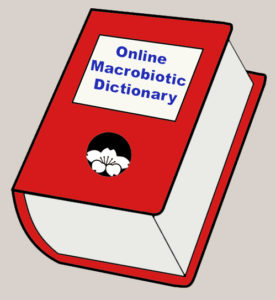
Completed Entries
Baked miso.
Contractive, having a contractive nature or effect. ‘Yangize,’ ‘yangization.’ Opposite of and complementary to yin. Something is “more yang” if its yang (centripetal, inward) force exceeds its yin (centrifugal, outward) force. “Centripetal yang produces the following phenomena: heat (thus, the activity of the molecular components); constriction; density; heaviness (thus, the tendency to go downward); flattened, low, horizontal forms. Philosophy of Oriental Medicine, 23.
Yang foods are those foods that make the body more yang (contractive) and, in general, if consume in excess, cause yang types of diseases. Examples of yang foods listed generally from most yang to least yang are: salt, salted products (umeboshi, miso, and soy sauce), eggs, red meat, poultry, salted cheeses, fish, shellfish, natural grain beverages, whole grains, and certain root vegetables.
A disease in which excess yang is considered to be the underlying cause.
The act of making something more yang by heat, pressure, salt, time (aging), and/or drying.
Grain coffee made from roasted whole grains and roasted azuki beans.
Expansive, having an expansive nature or effect. ‘Yinnize,’ ‘yinnization.’ Opposite of and complementary to yang. Something is “more yin” if its yin (centrifugal, outward) force exceeds its yang (centripetal, inward) force. “Centrifugal yin produces: cold (slackening of the components’ movement); dilation; expansion; lightness (thus, the tendency to go upward); enlargement; tall (in the vertical sense), thin forms.” Philosophy of Oriental Medicine, 23.
A disease in which excess yin is considered to be the underlying cause.
Yin foods are those foods that make the body more yin (expansive) and, in general, if consumed in excess, cause yin type diseases. Examples of yin foods listed generally from most yin to least yin are: chemicalized foods and drugs, refined sugar, candy, soft drinks, alcoholic drinks, honey, coffee, herb teas, dairy foods, bancha tea, fruits, beans, nuts, seeds, and vegetables.
The act of making something more yin by cold, relaxation, sugar, water, vitamin C, vinegar, ginger, spices, and/or fermentation.
Natural sweetener made from milled rice, barley, and koji enzyme.
Name given to the two poles/arms (complementary opposites) of the One Infinity that allows the invisible world to manifest as the visible finite world. It is a very useful tool, like a magic compass, because the interaction of yin-yang influences the destiny of all persons and things. See page 18 of this issue for sample macrobiotic yin-yang classifications of various opposites.
A kind of stew with vegetables, fish, chicken, and tofu.
Projected Entries
Yamaguchi, Alcan
Yamamoto, Shizuko
Yamazaki, Junsei (and Kazuko)
Yanagawa
Yannoh (Ohsawa coffee)
Yasuhara, Roland (Hisaoj)
Yeast
Yellow miso
Yinnization
Yin-yang balance
Yin-yang dialectical principle
Yellow Emperor, The
Yoshimi, Clim
Yuba
Yudofu
Questions or Comments?




